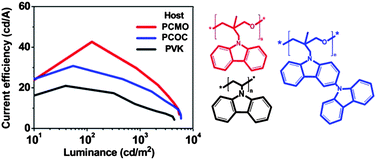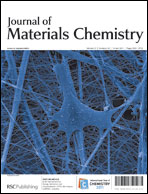Highly efficient blue organic light-emitting diode with an oligomeric host having high triplet-energy and high electron mobility
Abstract
We report a high-efficiency blue organic light-emitting diode (OLED) with a solution-processed emissive layer composed of an oligomeric host of poly[3-(carbazol-9-ylmethyl)-3-methyloxetane] (PCMO) that possesses high triplet-energy and high electron mobility. The device exhibited a current efficiency of 40.4 cd A−1 with an external quantum efficiency (EQE) of 21.6% and power efficiency of 28.2 lm W−1 at 230 cd m−2 or 24.7 cd A−1, 10.3%, and 15.5 lm W−1 at 1 000 cd m−2. The high efficiency may be attributed to the host possessing a high electron mobility and lower electron injection barrier, resulting in a more balanced carrier-injection. Moreover, the high electron-mobility favors the transport of electrons, resulting in a more balanced carrier-injection in the emissive layer. The device efficiency has been further enhanced to 42.6 cd A−1 (22.9%, 29.7 lm W−1) at 124 cd m−2 or 28.8 cd A−1 (15.4%, 17.8 lm W−1) at 1 000 cd m−2 by pre-heating the emissive solution at an elevated temperature before


 Please wait while we load your content...
Please wait while we load your content...